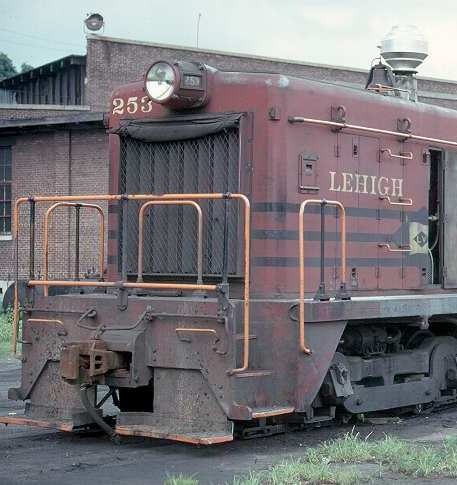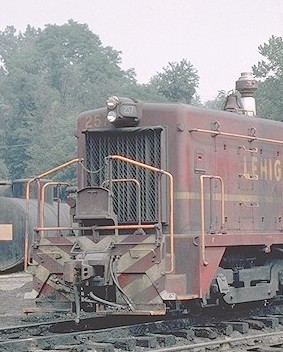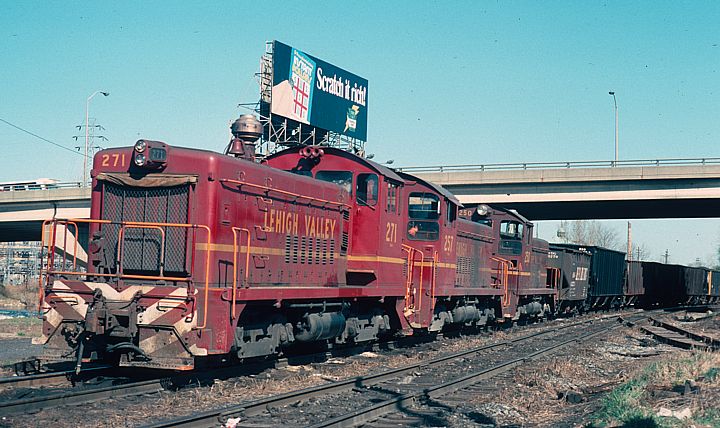
The westbound “Hazelton Man,” led by three pups, passes through Allentown. Photo by Rich Jahn
The Prototypes
Lehigh Valley’s SW8s were delivered over a 24 month period between December 1950 and December 1952, in several variations. The major operational differences were the specially designed dynamic brake installation, unique to the Valley’s SW8s, and MU capability. All 18 of the DB equipped units had MU capability at both ends, with the attendant split railings and drop steps. These were purchased specifically to run in groups of three to five, hauling anthracite on the M&H Division (later called the Hazelton Branch). Seven of the non-DB-equipped units had MU on the cab end only, with a straight end railing on the front end, so they could be run in pairs, back to back. At least one of these units was later retrofitted with MU on the front, but the railing was probably not changed. Two had no MU capability at all.
The other as-delivered variation was the use of single or dual headlights, probably a change in standard equipment by EMD between the delivery of the first and second batches. Other variations appeared as the SW8s were shopped, based on operating experience. The first were probably cloth radiator covers, to maintain operating temperatures in the Pocono winters, possibly by the end of 1952. Spark arrestors were also soon fitted, at first home-made half-round screens, which were oriented either front-to-back or crosswise in individual installations. Later, commercial Harco cyclone spark arrestors were fitted, in two sizes, probably as the result of at least two orders for them. Variations in horns can be seen in photos of some units, and at least one unit (264) had its front footboards replaced with a plow-like pilot.
The original Cornell Red with black stripes paint scheme lasted until Conrail Day on 14 out of the Valley’s 27 SW8s. Three were repainted into variations of the Tuscan Red scheme in the 60s and early 70s, which again lasted until Conrail, while 10 got the final Cornell Red scheme with yellow stripe and gothic lettering.
The table at the bottom of this page lists the details applicable to each unit.
Spotting Features and Detail Variations
| Individual Differences in LV’s SW8s # 250 – 276 | ||||||||
| Road Number | EMD Number | Delivery Date | Repaint Dates1 & Styles2 | Disposal | As delivered | Comments & Photo References | ||
| DB | MU | Headlights | ||||||
| 250 | 13151 | 12/1950 | 4/1972 – Style #6: Tuscan w yellow stripe, white flag & gothic lettering | To CR as 8664 | N | 1 | 1 | Photos by Bill Navari on George Ellwood’s web site show 8/72 and 4/77 views. |
| 251 | 13152 | 12/1950 | 11/1964 – Style #4: Tuscan w yellow stripe, gray flag in diamond & Roman lettering | To CR as 8665 | N | 1 | 1 | Photo by Bill Navari on George Elwood’s web site. |
| 252 | 13153 | 12/1950 | Never repainted to another scheme | To CR as 8666 | N | 1 | 1 | |
| 253 | 13154 | 12/1950 | Never repainted to another scheme | To CR as 8667 | N | 1 | 1 | Photo by Bill Navari on George Elwood’s web site. |
| 254 | 13155 | 12/1950 | Never repainted to another scheme | To CR as 8668 | N | 1 | 1 | James Mack photo on Clint Chamberlin’s web site.Gary Steubben photo on George Ellwood’s web site. |
| 255 | 13156 | 12/1950 | 10/1973 – Style # 11:Late Cornell Red, yellow stripe, no herald, gothic lettering. | To CR as 8669 | N | 1 | 1 | Photo on Clint Chamberlin’s web site.MU retrofitted to front end 10/73, and front railing style changed to split type. |
| 256 | 14027 | 8/1951 | Never repainted to another scheme | To CR as 8670 | Y | 2 | 2 | |
| 257 | 14028 | 9/1951 | 6/1973 – Style # 11:Late Cornell Red, yellow stripe, no herald, gothic lettering. | To CR as 8671 | Y | 2 | 2 | Photo in original scheme by Frank Czajkowski on Clint Chamberlin’s web site.Photo in repaint scheme on Clint Chamberlin’s web site. |
| 258 | 14029 | 9/1951 | Never repainted to another scheme | To CR as 8672 | Y | 2 | 2 | B&W photo on Clint Chamberlin’s web site. |
| 259 | 14030 | 9/1951 | 1/1973 – Style # 11:Late Cornell Red, yellow stripe, no herald, gothic lettering. | To CR as 8673 | Y | 2 | 2 | |
| 260 | 14031 | 9/1951 | Never repainted to another scheme | To CR as 8674 | Y | 2 | 2 | Troy Smith photo on Clint Chamberlin’s web site. |
| 261 | 14032 | 9/1951 | Never repainted to another scheme | To CR as 8675 | Y | 2 | 2 | Arnold Morscher photo on his web site. |
| 262 | 14056 | 9/1951 | Never repainted to another scheme | To CR as 8676 | Y | 2 | 2 | Bill Navari photo on George Ellwood’s web site. |
| 263 | 14057 | 9/1951 | 11/1972 – Style # 11:Late Cornell Red, yellow stripe, no herald, gothic lettering, but with lighter strokes in some letters, as in old LV style. | To CR as 8677 | Y | 2 | 2 | 1974 photo by Gary Steubben on George Elwood’s web site. |
| 264 | 14489 | 9/1951 | 2/1975 – Style # 11:Late Cornell Red, yellow stripe, no herald, gothic lettering. | To CR as 8678 | Y | 2 | 2 | Photo by Gary Steubben on George Elwood’s web site, showing plow pilot with black & white stripes applied sometime before full repaint in 2/1975 – body still in original Cornell Red scheme. |
| 265 | 14490 | 9/1951 | 1/1971 – Style #5:Tuscan, yellow stripe, white flag, Roman lettering. | To CR as 8679 | Y | 2 | 2 | B/W photo by J.R. Quinn (from Gary Steubben) on George Elwood’s web site, |
| 266 | 14491 | 9/1951 | Never repainted to another scheme | To CR as 8680 | Y | 2 | 2 | 1974 photo by Gary Steubben on George Elwood’s web site. |
| 267 | 14492 | 9/1951 | 4/1974 – Style # 11:Late Cornell Red, yellow stripe, no herald, gothic lettering. | To CR as 8681 | Y | 2 | 2 | |
| 268 | 14493 | 9/1951 | 8/1974 – Style # 11:Late Cornell Red, yellow stripe, no herald, gothic lettering. | To CR as 8682 | Y | 2 | 2 | Photo by Jerome Rosenfeld on George Elwood’s web site shows original paint scheme. Photo by Jim Parker on George Elwood’s site shows repaint scheme. |
| 269 | 14494 | 9/1951 | Never repainted to another scheme | To CR as 8683 | Y | 2 | 2 | 10-74 photo by Gary Steuben on George Elwood’s web site. |
| 270 | 14495 | 9/1951 | Never repainted to another scheme | To CR as 8684 | Y | 2 | 2 | Arnold Morscher photo on his web site. |
| 271 | 14496 | 9/1951 | 7/1974 – Style # 11:Late Cornell Red, yellow stripe, no herald, gothic lettering. | To CR as 8685 | Y | 2 | 2 | Had original split front railing as late as July 1973, but a straight front railing & no drop step in post-1974 photo by Rich Jahn. |
| 272 | 14497 | 9/1951 | Never repainted to another scheme | To CR as 8686 | Y | 2 | 2 | |
| 273 | 14498 | 9/1951 | 4/1974 – Style # 11:Late Cornell Red, yellow stripe, no herald, gothic lettering. | To CR as 8687 | Y | 2 | 2 | Still has MU, but a straight front railing & no drop step in photos after 4/74. |
| 274 | 16974 | 12/1952 | 4/1975 – Style # 11:Late Cornell Red, yellow stripe, no herald, gothic lettering. | To CR as 8688 | N | 1 | 2 | |
| 275 | 16972 | 12/1952 | Never repainted to another scheme | To CR as 8689 | N | 0 | 2 | |
| 276 | 16973 | 12/1952 | Never repainted to another scheme | To CR as 8690 | N | 0 | 2 | |
1. Dates in italics are estimates based on dates of available photos, and are subject to revision as new evidence comes to light. Non-italicized dates are actual repaint dates stenciled on the locomotives.
2. Paint style numbering system from Carl Steckler’s book.
References:
Bulletin No. 126, Lehigh Valley Issue, The Railway and Locomotive Historical Society, April 1972
Lehigh Valley Railroad Diesel Paint Schemes (1925-1976), by Carl Steckler.
LV Locomotive Assignment Roster, 10-21-75
Modeling
HO scale dynamic brake conversion kit for Life-Like Proto 2000 SW8 offered by ARHS
N scale dynamic brake conversion kit by Cutting Edge Scale Models: available in 2-pack or 5-pack
LV 261 in O Scale, by Lee Turner
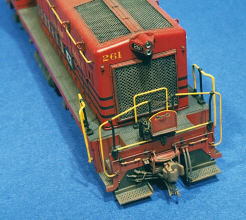
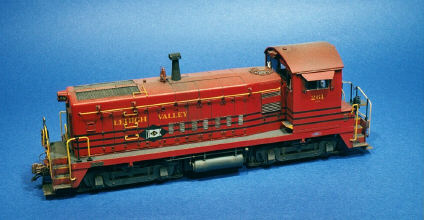
Lee’s 261 is an Atlas O scale model modified to a LV pup circa 1960-61. Lee added the dynamic brakes from styrene and modified the pilots for the LV’s MU configuration.
Tom Winlow’s HO Scale Model
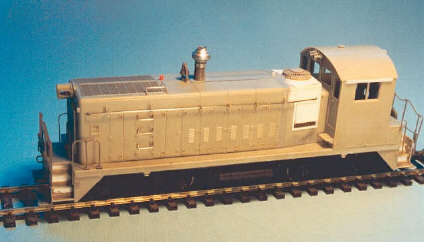
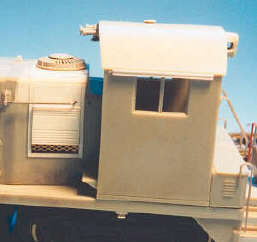
Model photos by Tom Winlow
This is built from a Proto 2000 SW9. I have commitments which will stop me finishing it for a couple of months but the last photos I took of it are attached. I made my own drawing for the dynamic brake installation. The best photo I found was in “Alcos To Allentown” (not an obvious place for an EMD loco!) . There is a photo somewhere about 2/3 of the way through which is a large side view showing only the dynamic area and the cab. It is really a photo of the crew but the fact that the cab is included makes scaling the dynamic bit pretty easy. [Arnold Morscher’s side view of 261 above on this page is also a good reference – Ed.]
I built mine by chopping out the area which is white in the photo and building up the hood/louvers etc in that area with styrene. The 1 ft or so of horizontal surface between the dynamic area and the cab is the original Proto 2000 shell filed flat – there’s just enough material.
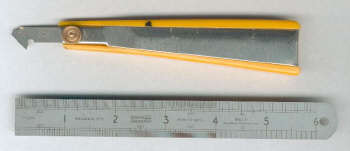 After much fiddling about with individual louvers I finally made the louvered part by scribing grooves using a hook-like cutter intended for scribing laminates. It is made by Olfa in Japan and produces a V-shaped groove, which isn’t correct but looks OK to me. I have attached a photo of the cutter – the scribing is done with the lowest point of the blade by pulling the handle towards you. It took a lot of very careful attempts before I managed to get a strip with all the grooves the same size. I scribed a long enough strip to make the dynamics for 3 Pups of which I’ve only started one so far. The diamond-mesh at the bottom of the air-intake is etched brass from a company here in England.
After much fiddling about with individual louvers I finally made the louvered part by scribing grooves using a hook-like cutter intended for scribing laminates. It is made by Olfa in Japan and produces a V-shaped groove, which isn’t correct but looks OK to me. I have attached a photo of the cutter – the scribing is done with the lowest point of the blade by pulling the handle towards you. It took a lot of very careful attempts before I managed to get a strip with all the grooves the same size. I scribed a long enough strip to make the dynamics for 3 Pups of which I’ve only started one so far. The diamond-mesh at the bottom of the air-intake is etched brass from a company here in England.
The part that is definitely wrong is the fan. I wanted a see-through fan so I could include fan blades. The only one I could find was (if I remember right) from Precision Scale and not really sufficiently low-profile. Even worse, the dome on the top of it was almost hemispherical so I filed it flat, replacing it with a less-domed one cut and filed from a Detal Assoc plastic fan I had in the scrap box. [Proto 2000 also sells six of the correct 36″ fans as detail part #584747 (SD7 Ventilators) – Ed.]
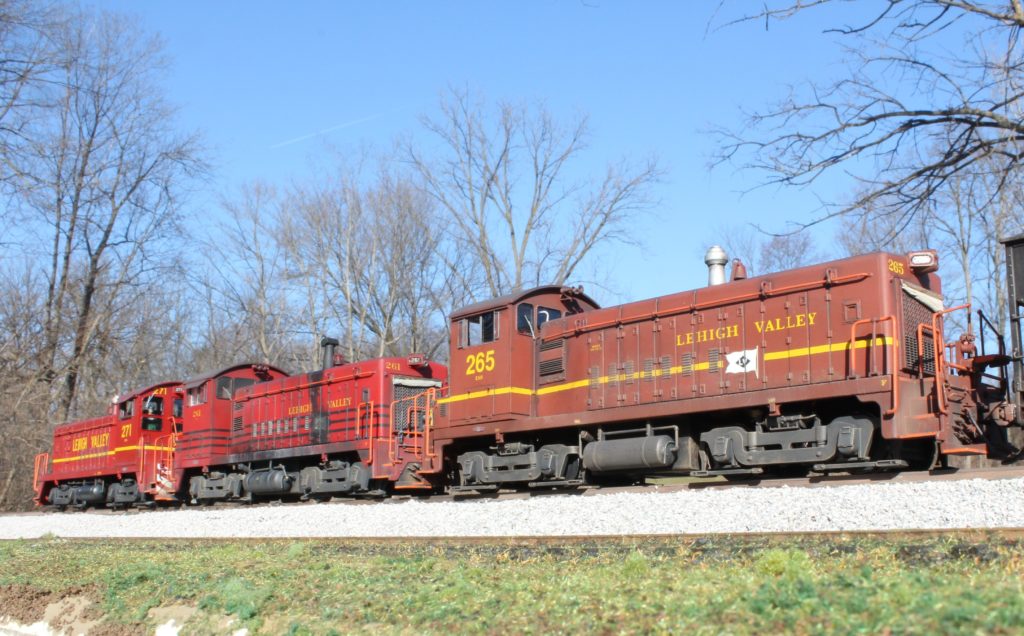

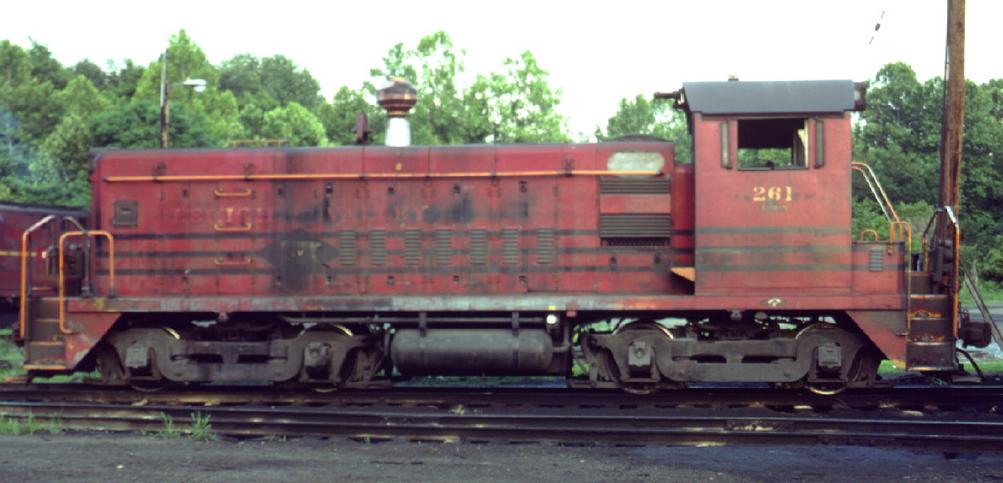
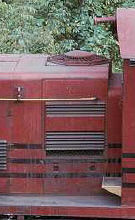
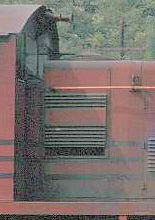
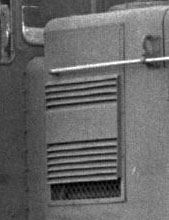 Don Johnson, ARHS collection
Don Johnson, ARHS collection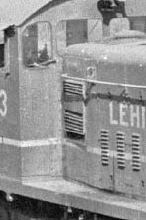 Rich Jahn, ARHS collection
Rich Jahn, ARHS collection